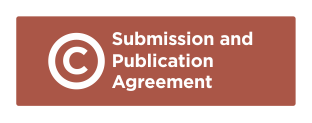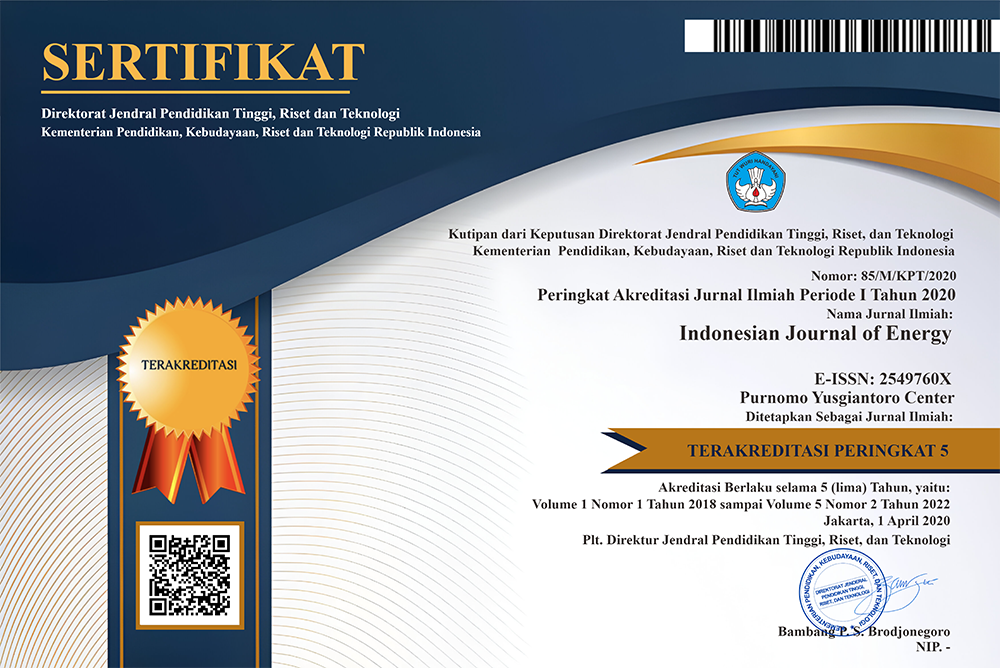Design of Integrated Electrochromic-Photovoltaic Technology for Smart Windows to Improve Building Performance and Energy Efficiency: A Material Approach
Abstract
Energy and climate problems that occur encourage the intensification of energy use efficiency, one of which is in buildings. The building sector is the largest contributor to energy consumption when compared to other sectors due to the need for comfort in life, including to regulate air temperature, ventilation, and artificial lighting. Window innovation as a building component leads to adaptive smart windows technology that has energy saving features. The use of these windows is attractive because they are designed to adapt to changing environmental conditions to minimize large heat losses by adjusting their transmissivity and conductivity. Various types of smart windows have developed, one of which is electrochromic technology as dynamic glass technology which has been widely used as smart windows in commercial buildings. Several studies have shown that its use in buildings has been shown to save energy consumption in buildings through the HVAC and lighting aspects. However, in today's technology, its performance still requires external power to adjust their optical conditions. Therefore, the innovation in developing electrochromic smart windows technology that is integrated with photovoltaic technology is an interesting thing to do. The combination of the electrochromic solution with photovoltaic Si-TFSC placed on a glass substrate provides promising optical performance and energy benefits. The integration of electrochromic and photovoltaic devices provides better efficiency in energy saving, because photovoltaic and electrochromic devices can achieve electrochromic layer discoloration without an external power source. Given the photoelectric and optical modulation properties of electrochromic photovoltaic windows that can function as solar cell modules as well as powered smart windows on their own, this technology has a major advantage in applying sustainable energy to buildings. In its application in buildings, to improve device performance, the control system can be applied by adjusting environmental conditions according to the sensor system readings to obtain better device performance.
Downloads
References
Ahn, K.-S., Yoo, S. J., Kang, M.-S., Lee, J.-W., & Sung, Y.-E. (2007). Tandem dye-sensitized solar cell-powered electrochromic devices for the photovoltaic-powered smart window. Journal of Power Sources, 168(2), 533–536.
Arifin, Z., Soeparman, S., Denny, W., Purwanto, A., & Dharmanto, D. (2017). Synthesis, characterisation, and fabrication hollow fibres of zn-doped tio2 for dye-sensitized solar cells. Journal of Engineering Science and Technology, 12, 1227–1239.
Askari, M., Mirzaei Mahmoud Abadi, V., & Mirhabibi, M. (2015). Types of solar cells and application. American Journal of Optics and Photonics, 3, 2015.
Balakrishnan, A., & Pattathil, P. (2019). Nanostructured electrochromic materials for smart switchable windows. CRC Press.
Barile, C. J., Slotcavage, D. J., Hou, J., Strand, M. T., Hernandez, T. S., & McGehee, M. D. (2017). Dynamic windows with neutral color, high contrast, and excellent durability using reversible metal electrodeposition. Joule, 1(1), 133–145.
Bechinger, C., Bullock, J. N., Zhang, J.-G., Tracy, C. E., Benson, D. K., Deb, S. K., & Branz, H. M. (1998). Low‐voltage electrochromic device for photovoltaic‐powered smart windows. Journal of Applied Physics, 80(2), 1226.
Buch, V. R., Chawla, A. K., & Rawal, S. K. (2016). Review on electrochromic property for WO3 thin films using different deposition techniques. Materials Today: Proceedings, 3(6), 1429–1437.
Cai, G., Eh, A. L.-S., Ji, L., & Lee, P. S. (2017). Recent advances in electrochromic smart fenestration. Advanced Sustainable Systems, 1(12), 1700074.
Cannavale, A., Ayr, U., Fiorito, F., & Martellotta, F. (2020). Smart electrochromic windows to enhance building energy efficiency and visual comfort. Energies, 13(6), 1449.
Casini, M. (2014). Smart windows for energy efficiency of buildings. Proc. of the Second Intl. Conf. on Advances In Civil, Structural and Environmental Engineering- ACSEE 2014, 10.
Chel, A., & Kaushik, G. (2018). Renewable energy technologies for sustainable development of energy efficient building. Alexandria Engineering Journal, 57(2), 655–669.
Chen, P.-W., Chang, C.-T., Ali, Md. M., Wu, J.-Y., Li, Y.-C., Chen, M.-H., Jan, D.-J., & Yuan, C.-T. (2018). Tantalum oxide film deposited by vacuum cathodic arc plasma with improved electrochromic performance. Solar Energy Materials and Solar Cells, 182, 188–195.
Choi, D., Lee, M., Kim, H., Chu, W., Chun, D., Ahn, S.-H., & Lee, C. S. (2018). Investigation of dry-deposited ion storage layers using various oxide particles to enhance electrochromic performance. Solar Energy Materials and Solar Cells, 174, 599–606.
Chopra, K., Paulson, P., & Dutta, V. (2004). Thin-film solar cells: An overview. Progress in Photovoltaics - PROG PHOTOVOLTAICS, 12, 69–92.
Chwieduk, D. (2003). Towards sustainable-energy buildings. Applied Energy, 76(1), 211–217.
Cl, G., Dm, W., & Jr, R. (2002). Poly(ProDOT-Et-2): A high-contrast, high-coloration efficiency electrochromic polymer. Macromolecular Rapid Communications, 23(15), 885–889.
Co, A., Ma, N., Ek, K., & Los, B. (2005). Electrodeposition of lead on ITO electrode: Influence of copper as an additive. Electrochimica Acta, 50(6), 1317–1321.
Corrado, V. (2018). Energy efficiency in buildings research perspectives and trends. Thermal Science, 22, 971–976.
Dao, L. H., & Nguyen, M. T. (1989). Design and optical modulation of electrochromic windows. Proceedings of the 24th Intersociety Energy Conversion Engineering Conference, 1737–1741.
de Torresi, S. I. C., & Carlos, I. A. (1996). Optical characterization of bismuth reversible electrodeposition. Journal of Electroanalytical Chemistry, 414(1), 11–16.
Deb, S. K., Lee, S.-H., Edwin Tracy, C., Roland Pitts, J., Gregg, B. A., & Branz, H. M. (2001). Stand-alone photovoltaic-powered electrochromic smart window. Electrochimica Acta, 46(13), 2125–2130.
Elool Dov, N., Shankar, S., Cohen, D., Bendikov, T., Rechav, K., Shimon, L. J. W., Lahav, M., & van der Boom, M. E. (2017). Electrochromic metallo-organic nanoscale films: Fabrication, color range, and devices. Journal of the American Chemical Society, 139(33), 11471–11481.
Eren, E., Karaca, G. Y., Koc, U., Oksuz, L., & Oksuz, A. U. (2017). Electrochromic characteristics of radio frequency plasma sputtered WO3 thin films onto flexible polyethylene terephthalate substrates. Thin Solid Films, 634, 40–50.
Fernandes, M., & de Zea Bermudez, V. (2021). Chapter 13—Sol-gel materials for smart electrochromic devices. In S. Das & S. Dhara (Eds.), Chemical Solution Synthesis for Materials Design and Thin Film Device Applications (pp. 439–475). Elsevier.
Fraas, L. M. (2014). The dream of thin film PV. In L. M. Fraas (Ed.), Low-Cost Solar Electric Power (pp. 73–79). Springer International Publishing.
Gao, W., Lee, S. H., Bullock, J., Xu, Y., Benson, D. K., Morrison, S., & Branz, H. M. (1999). First a-SiC:H photovoltaic-powered monolithic tandem electrochromic smart window device. Solar Energy Materials and Solar Cells, 59(3), 243–254.
Ghosh, A., & Norton, B. (2018). Advances in switchable and highly insulating autonomous (self-powered) glazing systems for adaptive low energy buildings. Renewable Energy, 126, 1003–1031.
Granqvist, C. G. (2014). Electrochromics for smart windows: Oxide-based thin films and devices. Thin Solid Films, 564, 1–38.
Gul, M. S., & Patidar, S. (2015). Understanding the energy consumption and occupancy of a multi-purpose academic building. Energy and Buildings, 87, 155–165.
Heckner, K.-H., & Kraft, A. (2002). Similarities between electrochromic windows and thin film batteries. Solid State Ionics, 152, 899–905.
Hsu, C.-Y., Lee, K.-M., Huang, J.-H., Justin Thomas, K. R., Lin, J. T., & Ho, K.-C. (2008). A novel photoelectrochromic device with dual application based on poly(3,4-alkylenedioxythiophene) thin film and an organic dye. Journal of Power Sources, 185(2), 1505–1508.
Huang, L.-M., Hu, C.-W., Liu, H.-C., Hsu, C.-Y., Chen, C.-H., & Ho, K.-C. (2012). Photovoltaic electrochromic device for solar cell module and self-powered smart glass applications. Solar Energy Materials and Solar Cells, 99, 154–159.
Huang, L.-M., Hu, C.-W., Peng, C.-Y., Su, C.-H., & Ho, K.-C. (2016). Integration of polyelectrolyte based electrochromic material in printable photovoltaic electrochromic module. Solar Energy Materials and Solar Cells, 145, 69–75.
Husain, A. A. F., Hasan, W. Z. W., Shafie, S., Hamidon, M. N., & Pandey, S. S. (2018). A review of transparent solar photovoltaic technologies. Renewable and Sustainable Energy Reviews, 94, 779–791.
International Energy Agency (IEA). (2019). Perspective from the clean energy transition. The critical role of buildings. International Energy Agency (IEA).
Ji, Y., Qin, C., Niu, H., Sun, L., Jin, Z., & Bai, X. (2015). Electrochemical and electrochromic behaviors of polyaniline-graphene oxide composites on the glass substrate/Ag nano-film electrodes prepared by vertical target pulsed laser deposition. Dyes and Pigments, 117, 72–82.
Ke, Y., Chen, J., Lin, G., Wang, S., Zhou, Y., Yin, J., Lee, P. S., & Long, Y. (2019). Smart windows: Electro‐, thermo‐, mechano‐, photochromics, and beyond. Adv. Energy Mater., 38.
Khanapuram, U., Bhat, S. D., Giridhar, V., & Aryasomayajula, S. (2016). Hybrid electrochromic device with Tungsten oxide (WO3-x) and nafion membrane: Performance with varying tungsten oxide thickness.
Lee, E. S., & Di Bartolomeo, D. L. (2002). Application issues for large-area electrochromic windows in commercial buildings. Solar Energy Materials and Solar Cells, 71(4), 465–491.
Liu, G., Liu, Y., Luo, N., Sun, Y., & Li, X. (2020). Preparation for electrochromic devices on PET substrate using screen printing. In P. Zhao, Z. Ye, M. Xu, & L. Yang (Eds.), Advanced Graphic Communication, Printing and Packaging Technology (pp. 271–277). Springer.
Lm, H., Ch, C., & Tc, W. (2006). Development and characterization of flexible electrochromic devices based on polyaniline and poly(3,4-ethylenedioxythiophene)-poly(styrene sulfonic acid). Electrochimica Acta, 51(26), 5858–5863.
Lu, Y., Liu, L., Mandler, D., & Lee, P. S. (2013). High switching speed and coloration efficiency of titanium-doped vanadium oxide thin film electrochromic devices. Journal of Materials Chemistry C, 1(44), 7380–7386.
Luo, G., Shen, L., Zheng, J., & Xu, C. (2017). A europium ion doped WO3 film with the bi-functionality of enhanced electrochromic switching and tunable red emission. Journal of Materials Chemistry C, 5(14), 3488–3494.
Mortimer, R. J. (2011). Electrochromic materials. Annual Review of Materials Research, 41, 241–268.
Nageib, A., Elzafarany, A. M., Elhefnawy, M. H., & Mohamed, F. O. (2020). Using smart glazing for reducing energy consumption on existing office building in hot dry climate. HBRC Journal, 16(1), 157–177.
Nakashima, M., Ebine, T., Shishikura, M., Hoshino, K., Kawai, K., & Hatsusaka, K. (2010). Bismuth electrochromic device with high paper-like quality and high performances. ACS Applied Materials & Interfaces, 2(5), 1471–1482.
Nunes, S. C., Saraiva, S. M., Pereira, R. F. P., Pereira, S., Silva, M. M., Carlos, L. D., Fortunato, E., Ferreira, R. A. S., Rego, R., & de Zea Bermudez, V. (2019). Sustainable dual-mode smart windows for energy-efficient buildings. ACS Applied Energy Materials, 2(3), 1951–1960.
Panagopoulou, M., Vernardou, D., Koudoumas, E., Tsoukalas, D., & Raptis, Y. S. (2019). Tungsten doping effect on V2O5 thin film electrochromic performance. Electrochimica Acta, 321, 134743.
Park, M. O. & J. (2019). Evaluation of building energy and daylight performance according to applying electrochromic and pdcl (polymer dispersed liquid crystal) to office building in South Korea. 227–240.
Qu, H., Zhang, H., Li, N., Tong, Z., Wang, J., Zhao, J., & Li, Y. (2015). A rapid-response electrochromic device with significantly enhanced electrochromic performance. RSC Advances, 5(1), 803–806.
Rai, V., Singh, R. S., Blackwood, D. J., & Zhili, D. (2020). A review on recent advances in electrochromic devices: A material approach. Advanced Engineering Materials, 22(8), 2000082.
Rajendran, N., & Charde, M. (2018). Smart technology used for active daylighting techniques mainly based on smart windows, artificial lighting and daylight harvesting. 17.
S, Z., Wd, H., Zs, G., B, J., & Db, X. (2019). A novel bis(dihydroxypropyl) viologen-based all-in-one electrochromic device with high cycling stability and coloration efficiency. Electrochimica Acta, 298, 533–540.
Salve, R. (2020). State of art of thin film photovoltic cell: A review. International Journal of Scientific Research in Science and Technology, 157–163.
Santa-Nokki, H., Kallioinen, J., & Korppi-Tommola, J. (2007). A dye-sensitized solar cell driven electrochromic device. Photochemical & Photobiological Sciences, 6(1), 63–66.
Sbar, N., Podbelski, L., Yang, H. M., & Pease, B. (2012). Electrochromic dynamic windows for office buildings. International Journal of Sustainable Built Environment, 1, 125–139.
Sharma, S., Jain, K., & Sharma, A. (2015). Solar cells: In research and applications—A review. Materials Sciences and Applications, 06, 1145–1155.
Soyleyici, H. C. (2019). Electrochromic properties of multifunctional conductive polymer based on naphthalene. Optical Materials, 90, 208–214.
Tällberg, R., Jelle, B. P., Loonen, R., Gao, T., & Hamdy, M. (2019). Comparison of the energy saving potential of adaptive and controllable smart windows: A state-of-the-art review and simulation studies of thermochromic, photochromic and electrochromic technologies. Solar Energy Materials and Solar Cells, 200, 109828.
Tavares, P. F., Gaspar, A. R., Martins, A. G., & Frontini, F. (2014). Evaluation of electrochromic windows impact in the energy performance of buildings in Mediterranean climates. Energy Policy, 67, 68–81.
Tc, L., Wh, C., Hy, L., & Lc, C. (2016). Multicolor electrochromic thin films and devices based on the Prussian blue family nanoparticles. Solar Energy Materials and Solar Cells, 145, 26–34.
Tsuboi, A., Nakamura, K., & Kobayashi, N. (2014). Multicolor electrochromism showing three Primary color states (cyan–magenta–yellow) based on size- and shape-controlled silver nanoparticles. Chemistry of Materials, 26(22), 6477–6485.
Türkoğlu, S., & Kardogan, P. O. (2017). The role and importance of energy efficiency for sustainable development of the countries. 3rd International Sustainable Buildings Symposium, 53–60.
Vergaz, R., Barrios, D., Sánchez-Pena, J.-M., Pozo-Gonzalo, C., & Salsamendi, M. (2009). Relating cyclic voltammetry and impedance analysis in a viologen electrochromic device. Solar Energy Materials and Solar Cells, 12(93), 2125–2132.
Wang, J., Zhang, L., Yu, L., Jiao, Z., Xie, H., Lou, X. W. D., & Sun, X. W. (2014). A bi-functional device for self-powered electrochromic window and self-rechargeable transparent battery applications. Nature Communications, 5, 4921.
Wang, Y., Runnerstrom, E. L., & Milliron, D. J. (2016). Switchable materials for smart windows. Annual Review of Chemical and Biomolecular Engineering, 7(1), 283–304. https://doi.org/10.1146/annurev-chembioeng-080615-034647
Zakirullin, R., & Zakirullin, R. (2020). Grating optical filters for smart windows: Materials, calculations and prospects. AIMS Materials Science, 7(6), 720–771.
Zhang, L., Wang, B., Li, X., Xu, G., Dou, S., Zhang, X., Chen, X., Zhao, J., Zhang, K., & Li, Y. (2019). Further understanding of the mechanisms of electrochromic devices with variable infrared emissivity based on polyaniline conducting polymers. Journal of Materials Chemistry C, 7(32), 9878–9891.
Zhi, M., Huang, W., Shi, Q., Peng, B., & Ran, K. (2016). Enhanced electrochromic performance of vanadium pentoxide/reduced graphene oxide nanocomposite film prepared by the Sol–Gel method. Journal of The Electrochemical Society, 163(10), H891.
Zhou, J., Wei, Y., Luo, G., Zheng, J., & Xu, C. (2016). Electrochromic properties of vertically aligned Ni-doped WO3 nanostructure films and their application in complementary electrochromic devices. Journal of Materials Chemistry C, 4(8), 1613–1622.
Ziegler, J. P., & Howard, B. M. (1995). Applications of reversible electrodeposition electrochromic devices. Solar Energy Materials and Solar Cells, 39(2), 317–331.
















